INSTRUCTIONS TO CANDIDATES
- Answer all questions.
- Non-programmable calculators and mathematical tables may be used.
- Show all your workings.

QUESTIONS
QUESTION 1
You are provided with the following:
- Two dry cells and a cell holder
- One voltmeter (0 – 5V)
- One ammeter (0 – 1A) or (0 – 2.5A)
- Six resistors labeled AB
- One resistor labeled R
- A switch
- 6 connecting wires with crocodile clip at one end
- Jockey attached to a connecting wire
- Set up the circuit as shown in figure 1
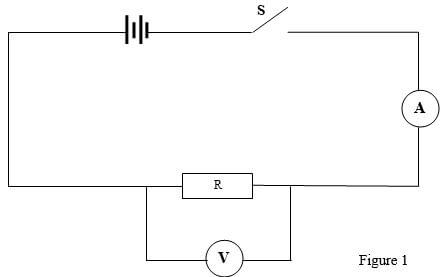
- Close the switch, s. Read and record the voltmeter and ammeter readings
V = ....................................(1mark)
I = ....................................(1mark) - Determine the value of R given that R = V/I (1mark)
- Close the switch, s. Read and record the voltmeter and ammeter readings
- Set the circuit as shown in figure 2
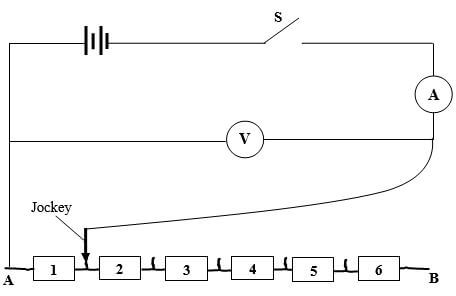
- With the jockey across resistor 1 as shown in figure 2 above, close the switch, read and record the ammeter and voltmeter readings in table.
- Repeat the procedure b (i) with crocodile clips across resistors 2, 3, 4, 5 and 6 respectively, each time recording the corresponding values for V and I in table 1
Table 1
(6 marks)Number of resistors
1
2
3
4
5
6
p.d. (volts)
Current I (Amperes)
- On the grid provided plot the graph of p.d (V) (y axis) against I (A) (5 marks)
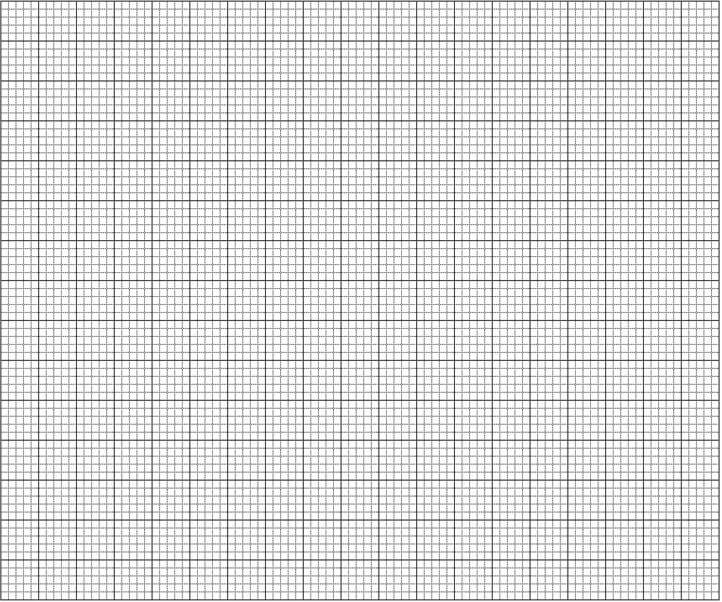
- Determine the slope of the graph (3 marks)
- Given that E = V + Ir use your graph and this equation to determine the value of: (3 marks)
- E
- r
PART A
You are provided with the following:
- Lump of plasticine
- 50g mass
- Stand, boss and clamp
- 3 pieces of threads
- Meter rule
- Measuring cylinder
- Some water in a beaker
- Put 50ml of water in a measuring cylinder.
Mould the plasticine into a shape that can fit into the measuring cylinder without touching its wall and tie it with the thread and completely immerse it in water in the measuring cylinder to determine it volume, V.
V=…………………… (1mark)
V=……………………m3 (1mark) - Given that upthrust, U experience by the plasticine in water is U=VꝬg
Where: V – volume of the 20g mass
Ꝭ - density of water (1g/cm3)
g – acceleration due to gravity
Determine upthrust U on the of plasticine (2 marks) - Tie the meter rule with the thread at the center (50cm mark) and suspend it on the stand as shown on the figure below.
- Tie 50g mass with the thread and suspend it on the meter rule at a distance d1 = 20cm from the center as shown on the figure.
- Suspend the plasticine on the meter rule and then adjust distance d2 of the plasticine such that the system balances horizontally as shown in the set up below.
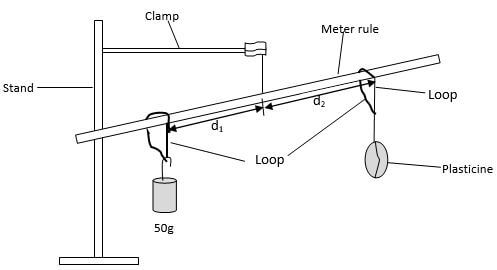
- Using the principle of moment determine the weight, W of the plasticine when the system is balancing horizontally. (2 marks)
- Immerse the suspended plasticine in the water in the measuring cylinder and adjust distance d3 of the plasticine such that the system balances horizontally as shown below
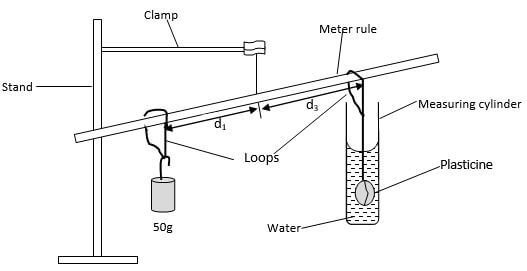
- Record the value of d3 (1mark)
- Given
 determine the value of R (2marks)
determine the value of R (2marks) - Repeat when d1 = 25 (1mark)
- Average of R (2 marks)
PART B
You are provide with
- Rectangular glass block
- Four optical pins
- Soft board
- Plain paper
- 2 thumb tacks
- Cellotape
- Vernier calipers (to be shared)
- 30cm Ruler
(L) Using the vernier calipers provided, measure and record the breadth b of the glass block
b=................................... (1mark)
(m) Place the plain sheet of paper on the soft board and fix it using the thumb pins. Place the glass block on the soft board and trace its outline.
(n) Remove the glass block and draw a normal at about 2cm from the end of the longer side of the glass block outline.
(o) Draw a line at an angle i = 100 from the normal. Fix two pins P1 and P2 on that line.
(p) Arrange the glass block and the plane mirror as shown below.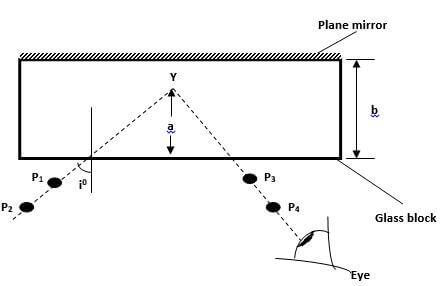
(q) By observing the images of the pins P1 and P2, locate the position pins P3 and P4 such that they appear in a line (no parallax) with pins P1 and P2
(r) Join the points P3 and P4 and extend them to intersect line P1P2 produced. Measure the perpendicular distance Y with the ruler.
(s) Repeat the procedure for other values of i and complete the table below.
|
Angle i0 |
20 |
30 |
40 |
|
Distance a (cm) |
|
|
|
(3 marks)
(t) Determine the average of the values of a (2 marks)
(u) Determine the values of constant k given that k = b/a (1 mark)
(v) State the quantity represented by answer in (j) above (1 mark)

MARKING SCHEME
QUESTION 1
You are provided with the following:
- Two dry cells and a cell holder
- One voltmeter (0 – 5V)
- One ammeter (0 – 1A) or (0 – 2.5A)
- Six resistors labeled AB
- One resistor labeled R
- A switch
- 6 connecting wires with crocodile clip at one end
- Jockey attached to a connecting wire
- Set up the circuit as shown in figure 1

- Close the switch, s. Read and record the voltmeter and ammeter readings
V = ...2.40 ± 0.20 V (accept 1 dp).(1mark)
I = ...0.24 ± 0.02 (Accept 2 dp only).........(1mark) - Determine the value of R given that R = V/I (1mark)
2.4 = 10 V/A
0.24
= 10.2
- Close the switch, s. Read and record the voltmeter and ammeter readings
- Set the circuit as shown in figure 2

- With the jockey across resistor 1 as shown in figure 2 above, close the switch, read and record the ammeter and voltmeter readings in table.
- Repeat the procedure b (i) with crocodile clips across resistors 2, 3, 4, 5 and 6 respectively, each time recording the corresponding values for V and I in table 1
Table 1
(6 marks)Number of resistors
1
2
3
4
5
6
p.d. (volts)
2.40 2.68 2.78 2.82 2.88 2.92 ± 0.2 Current I (Amperes)
0.26 0.14 0.09 0.07 0.06 0.04 ± 0.02
- On the grid provided plot the graph of p.d (V) (y axis) against I (A) (5 marks)
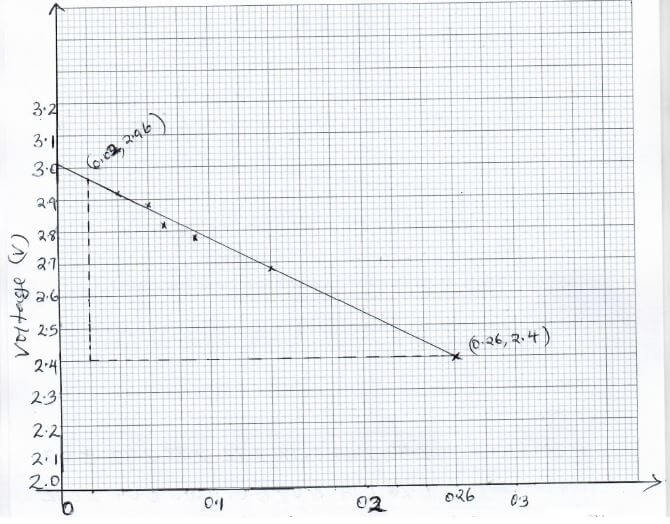
- Determine the slope of the graph (3 marks)
current I(A)
2.96 - 2.4 = 0.56 = -2.333V/A
0.02 - 0.26 -0.24
= -2.333 Ω - Given that E = V + Ir use your graph and this equation to determine the value of: (3 marks)
- E
E - Ir = V
V = -rI + E
E is the intercept on X-axis
= 3.02 ± 0.10v (accept 1 dp) - r
slope = -r
-r = -2.333
r = 2.333 Ω
- E
PART A
You are provided with the following:
- Lump of plasticine
- 50g mass
- Stand, boss and clamp
- 3 pieces of threads
- Meter rule
- Measuring cylinder
- Some water in a beaker
- Put 50ml of water in a measuring cylinder.
Mould the plasticine into a shape that can fit into the measuring cylinder without touching its wall and tie it with the thread and completely immerse it in water in the measuring cylinder to determine it volume, V.
V=…1.2 ± 1… (1mark)
V=…1.2 x 10-5 or 0.000012…m3 (1mark) - Given that upthrust, U experience by the plasticine in water is U=VꝬg
Where: V – volume of the 20g mass
Ꝭ - density of water (1g/cm3)
g – acceleration due to gravity
Determine upthrust U on the of plasticine (2 marks)
V = 1.2 x 10-5 x 1000 x 10
= 0.12 N - Tie the meter rule with the thread at the center (50cm mark) and suspend it on the stand as shown on the figure below.
- Tie 50g mass with the thread and suspend it on the meter rule at a distance d1 = 20cm from the center as shown on the figure.
- Suspend the plasticine on the meter rule and then adjust distance d2 of the plasticine such that the system balances horizontally as shown in the set up below.

- Using the principle of moment determine the weight, W of the plasticine when the system is balancing horizontally. (2 marks)
d2 = 20cm = 0.2m
0.5N x 0.08m = 0.2 x w
w = 0.2 N - Immerse the suspended plasticine in the water in the measuring cylinder and adjust distance d3 of the plasticine such that the system balances horizontally as shown below

- Record the value of d3 (1mark)
40.0cm ( ± 2.0cm) - Given
 determine the value of R (2marks)
determine the value of R (2marks)
40.0 = 40
40.0 - 20.0 20
= 2 - Repeat when d1 = 25 (1mark)
d3 = 50.0 ( ± 2.0 cm)
50 = 1.667
50 - 20 - Average of R (2 marks)
2 + 1.667 = 1.8335
2
PART B
You are provide with
- Rectangular glass block
- Four optical pins
- Soft board
- Plain paper
- 2 thumb tacks
- Cellotape
- Vernier calipers (to be shared)
- 30cm Ruler
(L) Using the vernier calipers provided, measure and record the breadth b of the glass block
b=..6.40 ± 0.20cm (2 dp a must ).. (1mark)
(m) Place the plain sheet of paper on the soft board and fix it using the thumb pins. Place the glass block on the soft board and trace its outline.
(n) Remove the glass block and draw a normal at about 2cm from the end of the longer side of the glass block outline.
(o) Draw a line at an angle i = 100 from the normal. Fix two pins P1 and P2 on that line.
(p) Arrange the glass block and the plane mirror as shown below.
(q) By observing the images of the pins P1 and P2, locate the position pins P3 and P4 such that they appear in a line (no parallax) with pins P1 and P2
(r) Join the points P3 and P4 and extend them to intersect line P1P2 produced. Measure the perpendicular distance Y with the ruler.
(s) Repeat the procedure for other values of i and complete the table below.
|
Angle i0 |
20 |
30 |
40 |
|
|
Distance a (cm) |
4.3 |
4.2 |
4.1 |
± 0.2 cm |
1 dp a must
punish for repeated values
(3 marks)
(t) Determine the average of the values of a (2 marks)
4.3 + 4.2 + 4.1 = 4.2 cm
3
(u) Determine the values of constant k given that k = b/a (1 mark)
k = 6.3 = 1.5
4.2
(v) State the quantity represented by answer in (j) above (1 mark)
refractive index of the glass

CONFIDENTIAL
INSTRUCTIONS TO SCHOOLS:
- The information contained in this paper is to enable the head of school and the teacher in charge of Physics to make adequate preparation for this Physics practical examination. NO ONE ELSE should have access to this paper or acquire knowledge of its contents. Great care MUST be taken to ensure that the information herein does not reach the candidates either directly or indirectly.
- The apparatus required by each candidate for the Physics Practical examination are set out on below. It is expected that the ordinary apparatus of a Physics laboratory will be available.
- The Physics teacher should note that it is his/her responsibility to ensure that each apparatus acquired for this examination agrees with the specifications as indicated on the list of apparatus below.
- The question paper will not be opened in advance.
- The Physics teacher is not expected to perform the experiments.
NB: Any use of apparatus other than the ones specified may lead to candidates being penalized.
QUESTION ONE
Every student should be provided with the following:
- Two size D dry cells and a cell holder
- One voltmeter (0 – 5V)
- One ammeter (0 – 1A) or (0 – 2.5A)
- Six carbon resistors each of 10Ω connected in series labeled AB

- One 10Ω resistor labeled R
- A switch
- 6 connecting wires with crocodile clip at one end
- Jockey attached to a connecting wire
QUESTION TWO
- Lump of plasticine weighing 20g
- 50g mass
- A Stand, boss and clamp
- 3 pieces of sewing threads each of length about 40cm
- Meter rule
- 100ml measuring cylinder
- Some water in a beaker
- Rectangular glass block
- Four optical pins
- Soft board
- Plain paper
- 2 thumb tacks
- Some cellotape 10cm long
- Vernier calipers (can be shared)
- 30cm Ruler (Students to come with their own)
Download Physics Paper 3 Questions, Answers and Confidential - Bunamfan Post Mock 2021 Exams.
Tap Here to Download for 50/-
Get on WhatsApp for 50/-
Why download?
- ✔ To read offline at any time.
- ✔ To Print at your convenience
- ✔ Share Easily with Friends / Students

